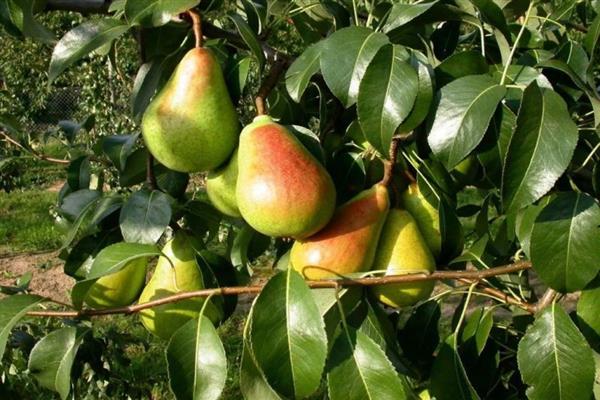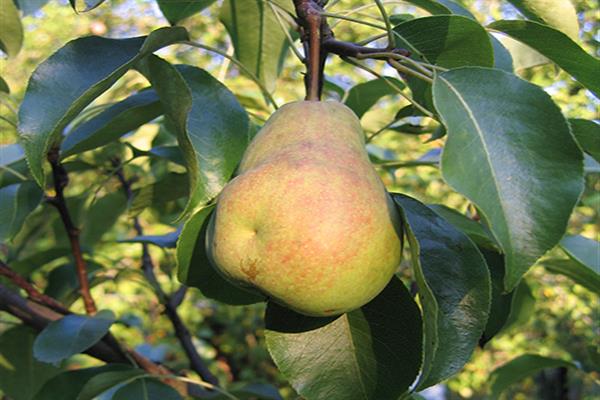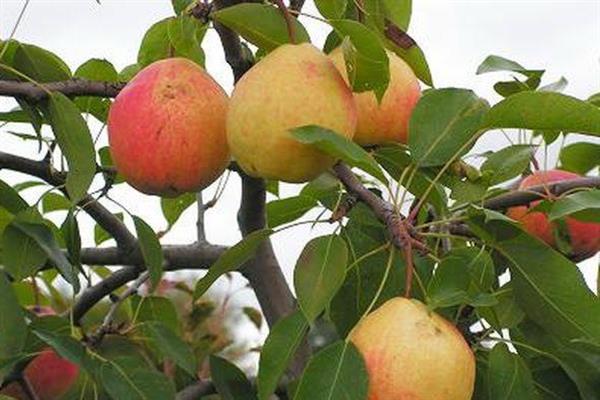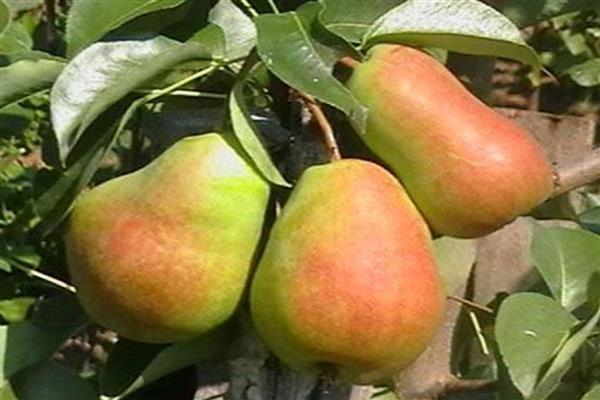Pear Cathedral
Content:
A striking example of such representatives of pear varieties is the Cathedral pear, in this article we will get to know it a little closer. She does not possess any incredible features, she is a modest beauty, not pretentious in care, with good indicators of immunity and resistance to weather conditions. Having planted a cathedral pear on your plot, you can be sure of a good annual harvest.
Pear Cathedral: description of the variety and characteristics

Pear Cathedral: photo of the variety
Pear Cathedral was obtained over twenty years ago, thanks to the works of two originators S.P. Potapov. and Chizhova S.T., and in the ninetieth year was put to the test.
The cathedral pear variety was bred as a result of crossing two hybrids, we will not delve into their numbered designations, and indicate the crossing varieties:
For a long eleven years, the future Cathedral pear was tested, and finally, in two thousand and one, it was registered in the Russian register. Initially, the variety was focused on planting and growing in the Central region, but gardeners are people who love experiments and over time it became obvious that it grows well in the middle Urals and even in Siberia.
Trees of the cathedral pear variety are not large in size and reach a height of three to four meters. The cone-shaped crown of the plant is not dense with sparse branches raised upward. The trunk and skeletal branches are covered with a smooth ash-gray bark. New shoots differ in color and are colored chocolate, with glimpses of burgundy, and their ends look down.
Leaf sizes vary from medium to large. The tip of the leaf plate is sharp with small denticles, the color is pale green. The leaves are smooth on both sides, from the outside they shimmer with gloss, dense veins run across the entire area. The buds on the tree are formed in the shape of a cone, rather voluminous and slightly bent. During the flowering period, the pear is covered with cup-shaped snow-white flowers of large diameter.
Please note that 90% of the fruits are formed on simple fruit branches, and only 10% on annuals.
Pear Cathedral is generally recognized as a summer variety, but all this is only conditional, since the timing can shift from many external factors. As a result, you can shoot the crop throughout August. But in any case, with the onset of autumn, your tree will complete the fruiting process.
One of the advantages of this variety is its early maturity. You will receive the first harvest already three to four years after planting in a permanent place, after which fruiting will become constant, and its number will increase every year.
One adult pear tree gives about 37 kg of fruit, if we consider such an indicator on an industrial scale, then this is about 95 centners per hectare, there are documented cases of obtaining 129 centners per hectare.
Cathedral pear needs the help of pollinator plants, although it is considered self-fertile. If you do not want to lose your harvest, then plant in the neighborhood those varieties of pears for which the flowering period will be similar.
This variety is able to withstand temperatures as low as minus thirty degrees, and grows well in conditions where other varieties die.
In addition, the cathedral pear has one huge plus, it has the highest resistance to scab and other fungal infections.
Features of the variety

Pear Cathedral: photo of the variety
The fruits of the cathedral pear variety have the correct shape for a pear with slightly noticeable tubercles on the outside. The fruit is far from being a palm tree in size among all varieties of pears, the weight varies from one hundred and twenty to one hundred and forty grams. But fortunately, the small size does not diminish the advantages of the variety, the fruits of the Cathedral pear are widely used in conservation. Ideal for compotes, where the pear is not cut, but the whole pear is placed in a jar.
The rind is smooth, pleasant to the touch and glossy. The pulp of the fruit is a little loose, but not soft, rather it can be called grainy and juicy, the color is light, light beige, close to white. Pears of this variety do not have a bright, but characteristic aroma for themselves. The chemical composition contains about 9% sugars and 16% dry matter.
The fruits of the Cathedral pear are green most of the time on the tree, including the moment of technical maturity. When fully ripe, it often changes to a creamy yellow.
Please note that on that part of the pear that is turned towards the sunlight, a pink-red blush is formed, it has no clear boundaries and covers a small part of the fruit surface. This feature makes them very presentable.
The entire skin of the fruit is strewn with slightly noticeable dots of an ash-marsh color.
The peduncle is not large in size, dense, curved in shape. The seeds are small and not in large quantities.
Pears have a characteristic sourness, but they are mostly sweet and saturated with juice. The variety is best eaten fresh. Due to the fact that the storage time of the crop is very short and does not exceed fifteen days, it is worth considering in advance the options for processing and harvesting. The fruits of the Cathedral pear are perfect for preparations based on cooking, grinding and juices, in addition, you should never forget about dried fruits.
Experts give the cathedral pear variety a solid four points for taste and 4.3 points for external characteristics.
Important to rememberthat in the process of harvesting, it is worth giving preference to manual labor and, for better safety during possible transportation, immediately neatly, avoiding damage, put them in boxes.
Pear Cathedral: advantages and disadvantages
The cathedral pear tree has many positive qualities, it is they who put it in the top ten favorite varieties of gardeners.
Let's designate them:
- It survives severe frosts and other weather changes very well.
- The first crop is brought three years after planting in a permanent place.
- Has a very high resistance to scab and many others.
- Each year gives a good harvest performance.
except pluses the pear variety Cathedral has some minuses:
- Not a long storage period for the crop, as well as low transportability.
- The fruits are not large.
Pear Cathedral: cultivation of a variety

Pear Cathedral: photo of the variety
Almost all varieties of pears react negatively to stagnant groundwater and excess moisture in the area of the root collar, the Cathedral pear will be no exception. For this reason, when choosing a place for planting a seedling on your site, be sure to monitor the withdrawal of groundwater. Alternatively, some gardeners plant the pear on an artificial embankment or a box made from wooden beams on their own.
It is important to take into account during the planting process that the root collar should not be buried in the soil. The best option is when the neck is flush with the ground, but it is considered ideal that it protrude a few centimeters above the ground, and in no case be buried in the soil.
Pear Cathedral prefers the soil of medium and low density, sandy or sandy loam in composition. Gardeners advise mixing the soil when planting with sand or ash.
Pay special attention to the nutrition of a young tree with nitrogen-containing preparations, only in the second year from the moment of planting.
In the first year of development of the described variety, adding such fertilizer can harm the tree.
Maximum care for the plant will be required during the period of preparation of the tree for fruiting. For the cold period of the year, which in its duration can vary depending on the region of cultivation, it is required to provide protection from direct sunlight and rodents. A young seedling needs more frequent watering, with the growth process their frequency decreases.
Pear Cathedral: reviews of gardeners

Pear Cathedral: photo of the variety
In 90% of cases, gardeners give positive feedback about the Cathedral pear, it does not require the creation of any difficult conditions for growing, it feels great in the latitudes of our country, and also gives a bountiful harvest of the most delicate and fragrant fruits.
Svetlana, 25 years old, Rumyantsevo.
The cathedral pear tree is my favorite. I planted it three seasons ago, along with another Detsky variety. This summer, it was the cathedral pear that set many fruits, at first glance from 40 to 60 pieces, and some of them have even acquired a characteristic blush. The whole family already had time to taste the first pears, the incredible taste conquered everyone with sugar with a slightly noticeable sourness. In my opinion, this variety is an excellent alternative to representatives of southern latitudes, this variety grows wonderfully in the Moscow region. And the dimensions of the tree allow you to harvest without problems.
Julia, 40 years old, Borisovo village.
I dreamed of planting a pear on my site for several years. Before a positive result, I spent more than a year, and tried several varieties. Some of the planted varieties simply froze out due to inappropriate care and my inexperience, some acquired gigantic sizes inadequate to the characteristics, and the fruits were completely tasteless. My hands dropped, and I almost admitted that I would not grow my dream in my latitudes. But a neighbor on the site advised me a variety of Cathedral pear, plus this is a self-fertile plant. Fortunately, there was no limit when, after some four years, the first fruits were formed on the tree. The taste was perfect for me, this was what I was striving for so much. The only disappointment was the number of pears. Having turned to specialists for help, we came to the conclusion that it was necessary to vaccinate a pollinator. I myself did not do this due to the lack of confidence in my capabilities, but an agronomist friend helped me and now I am sure that next year my beautiful Cathedral pear will delight me with a bountiful harvest.
Mikhail, 33 years old, Kopeysk.
I have a wealth of experience in the cultivation of pear and apple trees. I can't help but notice that it was the Cathedral Pear that delighted me with its resistance to low temperatures. I had the experience of planting Caucasian and snow pears, but even they did not take the palm in these criteria. The taste and the volume of the harvest also delighted me. While studying and choosing this variety, I drew attention to its similarity to the Lada pear, but gave preference to the cathedral and I think that I did not lose in my decision. Although Lada was created by the same breeders, it loses a lot in terms of ripening rate, indicators of immunity to diseases and frost resistance.
conclusions
Pear Cathedral is not whimsical or picky, but growing it on your site, you can be sure that you will not be left without a crop. This pear tree is ideal for growing in private garden plots, even in the seedling stage, the culture is able to grow without trembling care. The cathedral pear variety is suitable for both an experienced gardener and a beginner.




